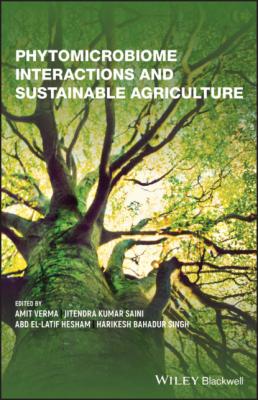Phytomicrobiome Interactions and Sustainable Agriculture. Группа авторов
Читать онлайн.| Название | Phytomicrobiome Interactions and Sustainable Agriculture |
|---|---|
| Автор произведения | Группа авторов |
| Жанр | Биология |
| Серия | |
| Издательство | Биология |
| Год выпуска | 0 |
| isbn | 9781119644828 |
Bacterial species depict a wide variation of the interaction pathways where pathogenicity is caused by manipulation and translocation of plant host cells. Depending upon the bacterial protein composition, the secretory pathways are classified into various types (Lee and Schneewind 2001). The first secretory pathway, i.e. type‐1 secretions are involved in secretion of phytotoxic substances such as rhizobiocin, hemolysins, etc., which are common to all phytopathogens. Though the majority of secretory pathways follow type 3 in which gram‐negative bacteria are responsible (Agrios 2004; Puhler et al. 2004). This pathway works on the principle where the effector protein is administered directly to the targeted host cell (Galan and Collmer 1999). The type‐2 system of secretion is another imperative pathway for bacterial pathogenicity. It is usually involved in the export of several virulent factors which are usually toxic. Miao and coworkers in their study in 2008 using various transcriptomic and proteomic approaches identified numerous genes and proteins involved in carbon and nitrogen metabolism, plant defense responses, nutrient exchange, and signal transduction that are significantly regulated in Glycine max colonized by Bradyrhizobium japonicum (Brechenmacher et al. 2010). Examples of a few interactions discussed in the chapter are listed in Table 2.2.
2.6 Conclusion and Future Prospects
The significance of agriculture and sustained crop production to meet the growing need around the world cannot be understated. Specific emphasis in the field of crops is imperative given the rising trends of the population at the global level. Precision, reliability, and accuracy in pathogenic disease detection and diagnosis have become crucial to optimize crop health, yield, and quality. Myriad of biological organisms have been observed to play a positive as well as negative impact on plant health. The positive impact can be enhanced with the aid of technology to increase the overall plant growth. The negative impact can potentially have damaging consequences to crop production worldwide, thereby affecting the overall productivity. Therefore, we need techniques with high‐level advancement to assess the phytomicrobial association to derive benefit or precautionary measures well within time. Substantial changes take place within the cell during phytomicrobiome association leading to translation of a novel protein occurring due to plant and microbe genome interactions. Derivation of information on genomics and transcriptomics of plants microbe interactions is available, however, the need of the hour is to validate the data using proteomics. Several classic and recent techniques such as 2DE, MS, ICAT, DIGE, and MudPIT are at our disposal which are now proving to be effective and reliable enough to give us a validated result. The first instinct for the proteome analysis makes use of 2DE and MS for the preliminary extraction and separation of proteins of interest. Subsequently, the techniques are chosen to further delve deep into cellular functions. Owing to their reproducibility of results the data thus generated by such proteomic approaches are proving to be reliable. Identification of protein using peptide mass fingerprinting is filled with constraints owing to the need for the large‐scale sequence of the genome.
Table 2.2 Examples of phytomicrobiome interactions.
| Microorganism | Plant | Habitation | (+/−) Impact of Interaction | Type of Interaction |
|---|---|---|---|---|
| Bacillus amyloliquefaciens | Lolium perenne | rhizospheric | + | Indirect |
| Pseudomonas sp. | Helianthus tuberosus | endophytic | + | Indirect |
| Rhizophagus irregularis | Gossypium (17 sp.) | rhizospheric | + | Direct |
| M. lychnis‐dioicae | Silene latifolia | epiphytic | − | Direct |
| Fusarium proliferatum | Solanum lycopersicum | endophytic | − | Direct |
There is also a necessity to integrate the proteome generated data within the network of bioinformatics software to make the in‐silico analysis of proteomics more structured. This enhances the ability of the protein‐related data to get the validation through in silico analysis. Proteomics has leaped ahead to genomic and transcriptomic studies by making the analysis as close to reality as practically possible. Advancement in proteomics has led the research to leapfrog into the analysis which was simply hypothesized earlier, thereby acting as an aspect that cannot be dispensed of in the field of biological sciences, especially in plant microbial consortium.
References
1 Agrios, G.N. (2004). Plant Pathology, 5e. San Diego: Academic Press.
2 Badri, D.V., Zolla, G., Bakker, M.G. et al. (2013). Potential impact of soil microbiomes on the leaf metabolome and on herbivore feeding behavior. New Phytol. 198: 264–273.
3 Bantscheff,
